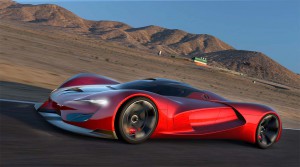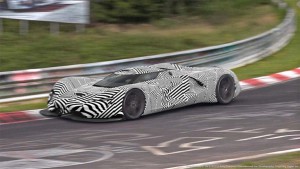
The Tomawhawk concept in a virtual street shot was created by the design team at FCA for the video game.
Vision Gran Turismo has emerged as a force of nature in the automotive world so Ralph Gilles, product design chief at Fiat Chrysler Automobiles, said he was excited when he received an e-mail more than a year from the Polyphony Digital Inc. asking if what was then Chrysler Group could provide a concept car for the famous video.
“I jumped up from my desk,” he said, and quickly began looking at ways to fulfill the request from Polyphony, a Sony subsidiary that provides the gaming software used on PlayStation. “Video games can touch millions and millions,” said Gilles, who noted that more than 73 million fans around the world play Gran Turismo.
Gilles explained that “lots of gamers” are also auto enthusiasts. In turn, many automotive designers are huge fans of gaming, said Gilles, who said he can spend hours involved in the gaming set-up at home, which he has outfitted with a special steering wheel for driving games on race courses all over the world.
As an active racer, he has learned how to drive a number of tracks on PlayStation, said Gilles, who added, “PlayStation literally changed my life.”
Gilles added he also understood that a large percentage of the design office staff was devoted gamers so he created a competition to seek the best potential design for a concept car that could fit in video game. Virtually everyone in the office participated in the initial round by submitting drawings of different types of racecars.
The designers basically worked on their own time in creating the concept and Gilles held a formal review, just like Chrysler would hold for the design of a new car or truck, before selecting the finalists. The design for what became the Tomahawk came from the pen of Paul Hoste, who was working for Jeep at the time, Gilles said.
“We do concept cars, but we don’t show them to the public anymore,” said Mark Trostle, the head of SRT and Dodge design. For one, companies have become much more guarded about future designs. But the drawings for the Tomahawk for PlayStation let designers stretch their imagination.
Trostel also said he wanted the Tomahawk concept car to be as realistic but futuristic as possible so he asked Mike Shinedling, manager of advanced concepts SRT engineering, to come up with a powertrain and other technology that could power the car.
The Tomahawk is powered by V-10 engine with the cylinders set at 144-degree angle and pneumatic hybrid that will drive the cars front wheels to give the car an extra boost so it can reach 400 mph, Shinedling said.
All of the transparent elements, including the cockpit and engine cover, are made from ultra-light graphene skins. The driver views the SRT Tomahawk Vision Gran Turismo’s instruments and communication system on a clear digital overlay on the graphene windshield.
(Is the Tomahawk returning? For more, Click Here.)
A large air intake for engine cooling is mounted on the hood. Active panels mounted above the front and rear fenders are constantly moving, via pneumatic assist, to create the optimal amount of aerodynamic downforce for braking assist and traction under acceleration.
An overhead view of the SRT Tomahawk Vision Gran Turismo is marked by a “pinched-waist” silhouette and an exposed aluminum spine channels air to help cool the V-10 engine. The imaginary surfaces are made of an experiment material with an atom structure that is a step beyond carbon fiber, Shinedling said.
Curved, voluptuous surfacing was used to create a timeless design that is accented by functional NACA-style air intakes on the front and large air intakes for engine and brake cooling on the side.
The rear of the SRT Tomahawk Vision Gran Turismo has been thoughtfully designed for high impact – as this is the primary view for the gamer. Thin LED lights and five large exhaust ports are integrated in the rear diffuser to create an intimidating and planted look.
(Click Here to find out how Ford is using 3D printing to win on the racetrack.)
With a full set of engineering and performance specifications developed by the SRT engineering team at FCA US, the capabilities of the SRT Tomahawk Vision Gran Turismo are rooted in an effort to push performance just beyond the limits of known science.
The entire vehicle design, from the driver position to the nearly flat layout of the V-10 engine, is intended to achieve the lowest possible center of gravity. The SRT Tomahawk Vision Gran Turismo was engineered and developed to the same uncompromising standards as any SRT vehicle on the road today. SRT engineers also worked in their spare time and on weekends to create three extremely fast cars that test the limits of human physiology.
Polyphony is also excited about the project.
“I’m truly happy that FCA and its performance division, SRT, has captured the spirit of the Vision Gran Turismo with the SRT Tomahawk Vision Gran Turismo,” said Kazunori Yamauchi, creator of Gran Turismo and president of Polyphony Digital, Inc. “FCA designers took part in a design competition and the concept that was chosen is extreme in every way with its striking form, aerodynamic proportions, internal mechanisms and advanced driver’s suit.
(To see more about Ford’s expected summer launch of Sync 3, Click Here.)
“Due to the radical design of the vehicle, our physics team had to develop new physics for Gran Turismo in order to represent the car properly in the game. We thank everyone at FCA who enjoyed the Vision Gran Turismo project and I am looking forward to the day when we can share the vision of SRT with Gran Turismo players.”

